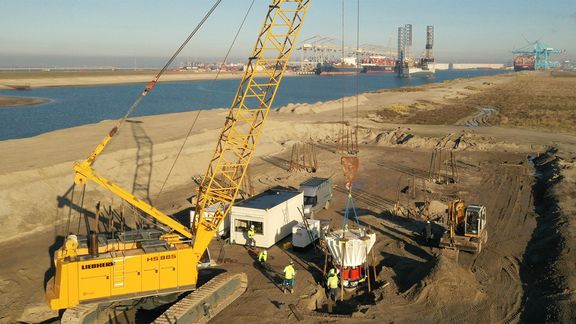Results of the foundation pile trial at Prinses Amaliahaven Rotterdam
Last winter’s trial with foundation piles at Prinses Amaliahaven in the Rotterdam port area of Maasvlakte has been successfully concluded. The study, during which foundation piles were purposely brought to the point of collapse under heavy loads, has yielded improved design guidelines for the foundations of civil engineering structures. These new insights can be directly applied to the development of new quay walls in Amaliahaven and Alexiahaven, saving millions of euros in investments and significantly reducing the volume of carbon emissions released during construction.

The trial is part of the Port of Rotterdam Authority’s Infra Innovation (I2) innovation programme. Through this programme, the Port Authority aims to lower costs, increase freight volumes per berth and reduce greenhouse emissions at Rotterdam’s berths, quay walls and navigation channels. A range of targeted and programmatic studies and innovations relating to maritime infrastructure are carried out within I2. The combined research results can help make the port of Rotterdam cleaner, smarter, more efficient and safer.
Results of the foundation piles trial
The trial results were used as input for the development of a more sustainable (in terms of carbon savings), safe and economical design for the foundation of the deep sea quays that will be realised this year in the Maasvlakte 2 port area. The relatively expensive screw piles have been replaced with vibro-piles. The trial results show that the latter are well suited to the purpose, as a result of which the direct construction costs for these foundation piles can be cut by around 50% (equivalent to over €10 million), while also halving the volume of CO2 released during construction (around 8,000 tonnes in carbon savings).
A major advantage of vibro-piles is that they use far less steel than screw piles, meaning they are a considerably more attractive option in terms of environmental impact. At least 10 km of deep sea quay still needs to be constructed at Maasvlakte 2. As a result of the trial, Rotterdam will be able to achieve significant carbon savings in the near future: according to expectations, over 30,000 tonnes of CO2. In the past, many of the existing quay walls at Maasvlakte were fitted with prefab concrete piles. The load-bearing capacity of these piles has proven to be approximately 25% higher than originally assumed. This makes it possible to improve the utilisation of these quay walls and extend the structures’ lifespan. The trial results can also be referred to when designing the foundations of other engineering structures at Maasvlakte.
For the Netherlands as a whole
The foundation pile trial has since been endorsed by the experts responsible for Nederlandse Praktijk Richtlijn (NPR) Geotechniek (a national geotechnical engineering guideline). This means the trial data has been included in the national test register managed by the standardisation agency Stichting Koninklijk Nederlands Normalisatie Instituut (NEN). From now on, anyone can access the results of the Rotterdam trial – enabling an extension of the lifespan of millions of foundation piles throughout the Netherlands.
Pile trial
The trial at Maasvlakte ran from 3 December 2019 to 21 January 2020.
It was intended as an in-depth study of the load-bearing capacity of specific foundation piles. Based on the results, the team has improved the design guidelines for the use of these piles at Maasvlakte in Rotterdam’s port area. A total of 11 foundation piles were subjected to heavy loads – to the point of collapse. During this trial, researchers also had the opportunity to test the significance of a new set of pile design factors stipulated by Eurocode 7, which was officially adopted in 2017. According to this new standard, the share of foundation piles used during the construction of quay walls needs to be increased by around 20 to 30% – even though pile foundation subsidence has never been an issue anywhere in the Netherlands.
A total of three different foundation pile types (prefab concrete piles, vibro-piles and screw piles) were put to the test. They were subjected to a test load of 25,000 kN (approximately 2.5 million kilograms). The entire length of the test piles was fitted with highly advanced calculation sensors, allowing researchers to map out in precise detail how and where the pile transferred the forces to the surrounding soil. This is the first time a trial of this kind has been conducted on this scale.
During the large-scale trial, the researchers worked together with experts from De Klerk, MariTeam, NPR, TU Delft, Deltares and WTCB. Supported by experts in the field of concrete, foundation piles, geotechnical engineering, quay walls and sensors/metrology, the team succeeded in arriving at new calculation guidelines and an innovative design solution.